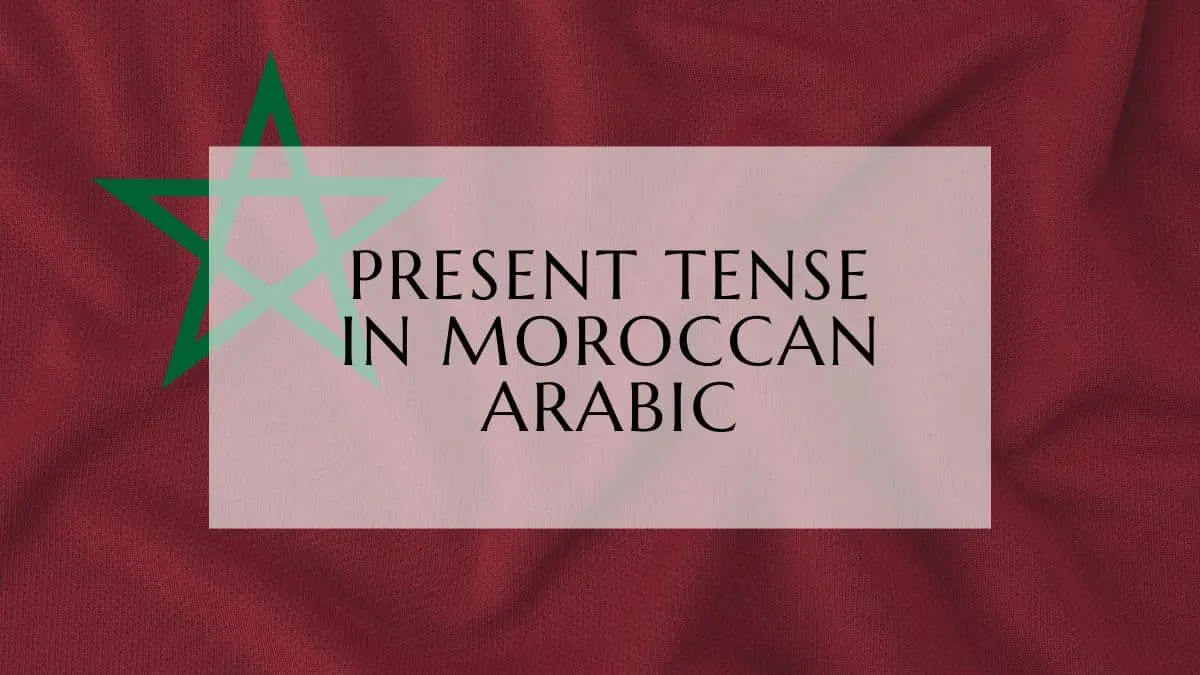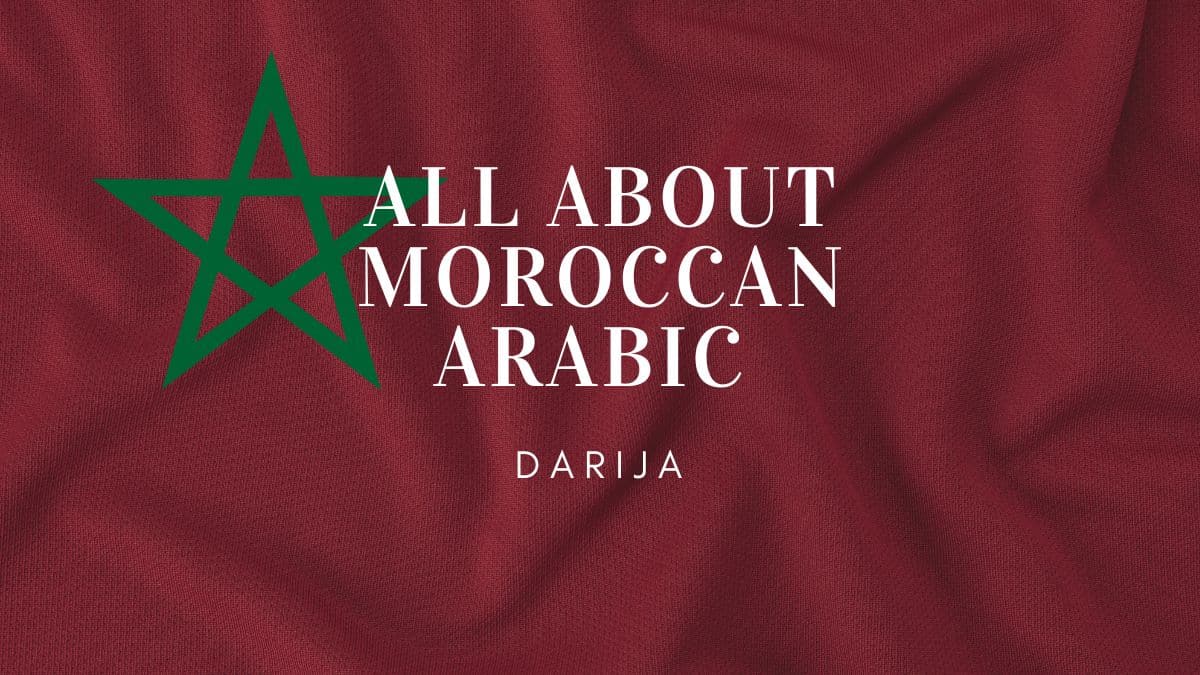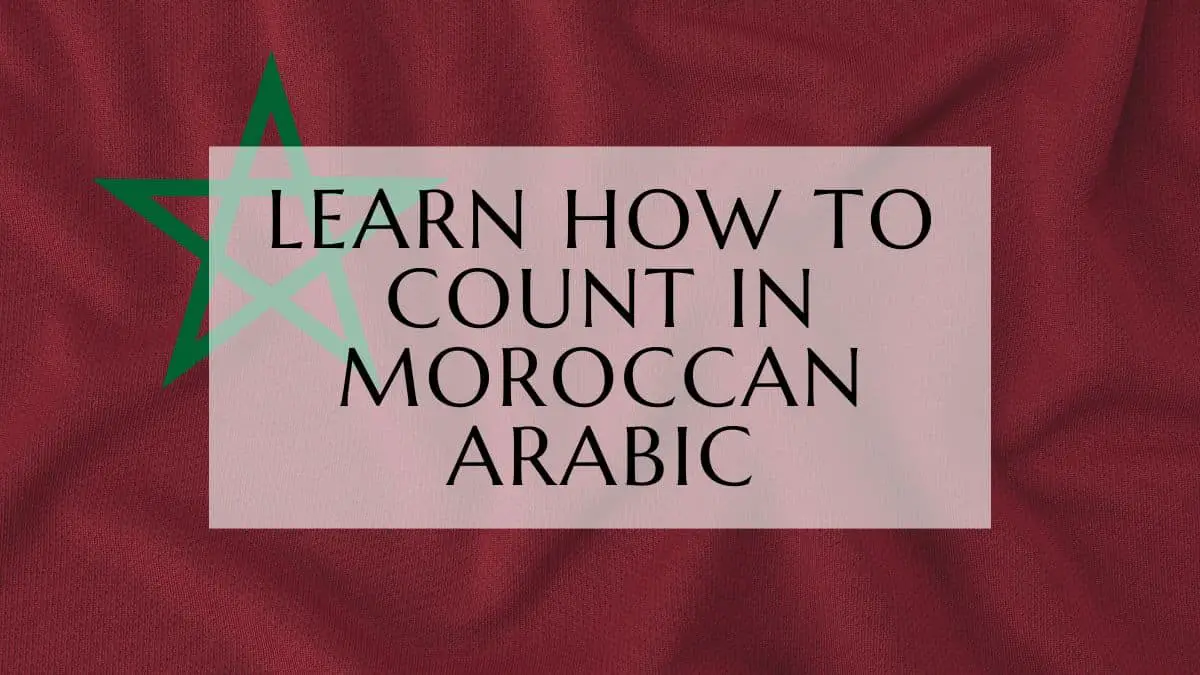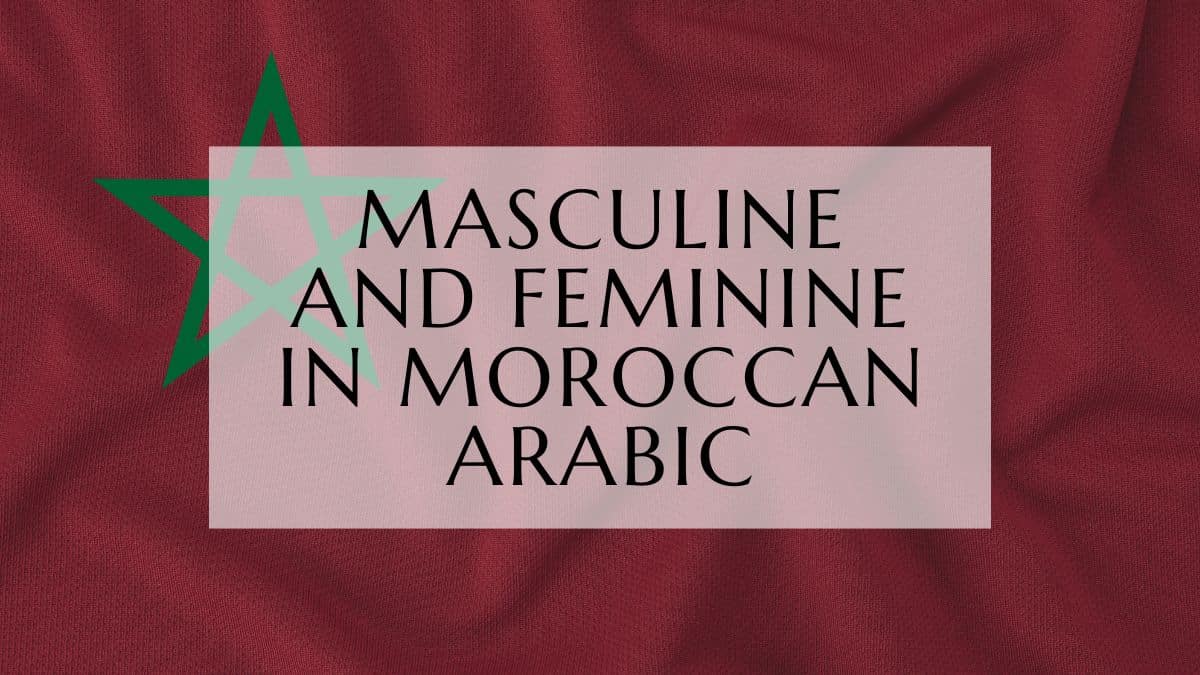The present tense in Moroccan Arabic is pretty straightforward as there is a simple form to apply to verbs to get the conjugation right, but bear in mind that there are 4 types of Darija verbs: CCV, CVC, CCC, and CC (C: Consonant and V: Vowel) which we will explain and give some examples.

Present Tense In Moroccan Arabic
The present tense conjugation of Moroccan Arabic follows this form:
| English | Transcribed Moroccan Arabic | Using Arabic Alphabet |
| I | Ana kan… | أنا كن… |
| You (feminine, singular) | Nti / Ntiya kat….i | نتي / نتيا كت…ي |
| You (masculine, singular) | Nta / Ntaya kat… | نتا / نتايا كت… |
| He | Howa kay… | هو كي… |
| She | Hia kat… | هي كت… |
| We | 7na kan…o | حنا كن…و |
| You (plural) | Ntuma kat…..o | نتوما كت…و |
| They | Huma kay…o | هوما كي…و |
Note that you can use t/ت instead of k/ك .
Present Tense Form For CCV And CVC Verbs
For this group, most verbs follow the form we talked about, for the few ones left, the vowel transforms to “i“, “o“, or stays the same:
CCV Verbs Form
Examples of CCV verbs (Consonant, Consonant, Vowel):
- Shra (to buy) شرا (a transforms to i)
- Kla (to eat) كلا (irrigular! tadaaa!)
- Msha (to go) مشا (a transforms to i)
Conjugation of shra:
| English | Transcribed Moroccan Arabic | Using Arabic Alphabet |
| I | Ana kanshri | أنا كنشري |
| You (feminine, singular) | Nti / Ntiya katshri | نتي / نتيا كتشري |
| You (masculine, singular) | Nta / Ntaya katshri | نتا / نتايا كتشري |
| He | Howa kayshri | هو كيشري |
| She | Hia katshri | هي كتشري |
| We | 7na kanshriw (o becomes w after i) | حنا كنشريو |
| You (plural) | Ntuma katshriw | نتوما كتشريو |
| They | Huma kayshriw | هوما كيشريو |
Short verbs as ja (to come) also fall into this category, here is its conjugation:
| English | Transcribed Moroccan Arabic | Using Arabic Alphabet |
| I | Ana kanji | أنا كنجي |
| You (feminine, singular) | Nti / Ntiya katji | نتي / نتيا كتجي |
| You (masculine, singular) | Nta / Ntaya katji | نتا / نتايا كتجي |
| He | Howa kayji | هو كيجي |
| She | Hia katji | هي كتجي |
| We | 7na kanjiw | حنا كنجيو |
| You (plural) | Ntuma katjiw | نتوما كتجيو |
| They | Huma kayjiw | هوما كيجيو |

CVC Verbs Form
Examples of CVC verbs(Consonant, Vowel, Consonant)
- Tar (to fly) طار (a transforms to i)
- Ban (to appear) بان (a stays the same)
Conjugation of tar:
| English | Transcribed Moroccan Arabic | Using Arabic Alphabet |
| I | Ana kantir | أنا كنطير |
| You (feminine, singular) | Nti / Ntiya kattiri | نتي / نتيا كطيري |
| You (masculine, singular) | Nta / Ntaya kattir | نتا / نتايا كطير |
| He | Howa kaytir | هو كيطير |
| She | Hia kattir | هي كطير |
| We | 7na kantiro | حنا كنطيرو |
| You (plural) | Ntuma kattiro | نتوما كطيرو |
| They | Huma kaytiro | هوما كيطيرو |
Present Tense Form For CCC And CC Verbs
Most verbs in Moroccan Arabic belong to this group of CCC and CC, and to conjugate them, you just add the form mentioned above.
CCC Verbs Form
Examples of CCC Verbs (Consonant, Consonant, Consonant):
- Ktb ( to write) كتب
- Shrb (to drink) شرب
- Gls (to sit) جلس
Conjugation of Ktb:
| English | Transcribed Moroccan Arabic | Using Arabic Alphabet |
| I | Ana kanktb | أنا كنكتب |
| You (feminine, singular) | Nti / Ntiya katktbi | نتي / نتيا كتكتبي |
| You (masculine, singular) | Nta / Ntaya katktb | نتا / نتايا كتكتب |
| He | Howa kayktb | هو كيكتب |
| She | Hia katktb | هي كتكتب |
| We | 7na kanktbo | حنا كنكتبو |
| You (plural) | Ntuma katktbo | نتوما كتكتبو |
| They | Huma kayktbo | هوما كيكتبو |
Note: verbs like attar are considered CCC as the second a is a short vowel (أتر)
ِConjugation of attar:
| English | Transcribed Moroccan Arabic | Using Arabic Alphabet |
| I | Ana kan attar | أنا كنأتر |
| You (feminine, singular) | Nti / Ntiya kat attari | نتي / نتيا كتأتري |
| You (masculine, singular) | Nta / Ntaya kat attari | نتا / نتايا كتأتر |
| He | Howa kay attar | هو كيأتر |
| She | Hia kat attar | هي كتأتر |
| We | 7na kan attaro | حنا كنأترو |
| You (plural) | Ntuma kat attaro | نتوما كتأترو |
| They | Huma kay attaro | هوما كيأترو |
CC Verbs Form
Examples of CC Verbs (Consonant, Consonant)
- Sed (to close) سد
- Keb (to pour) كب
Conjugation of keb:
| English | Transcribed Moroccan Arabic | Using Arabic Alphabet |
| I | Ana kankeb | أنا كنكب |
| You (feminine, singular) | Nti / Ntiya katkebi | نتي / نتيا كتكبي |
| You (masculine, singular) | Nta / Ntaya katkeb | نتا / نتايا كتكب |
| He | Howa kaykeb | هو كيكب |
| She | Hia katkeb | هي كتكب |
| We | 7na kankebo | حنا كنكبو |
| You (plural) | Ntuma katkebo | نتوما كتكبو |
| They | Huma kaykebo | هوما كيكبو |
Note: you can practice what you’ve learned here, and learn how to pronounce each of the words in our Memrise course here, don’t know how to use the platform or sign up? we’ve got you covered in this easy-to-follow tutorial here.
The Irrigulars Kla (to eat) and Khda (to take)
The Verb Kla in Present:
| English | Transcribed Moroccan Arabic | Using Arabic Alphabet |
| I | Ana kanakul | أنا كناكل |
| You (feminine, singular) | Nti / Ntiya katakli | نتي / نتيا كتاكلي |
| You (masculine, singular) | Nta / Ntaya katakul | نتا / نتايا كتاكل |
| He | Howa kayakul | هو كياكل |
| She | Hia katakul | هي كتاكل |
| We | 7na kanaklu | حنا كناكلو |
| You (plural) | Ntuma kataklu | نتوما كتاكلو |
| They | Huma kayaklu | هوما كياكلو |
The Verb Khda in Present:
| English | Transcribed Moroccan Arabic | Using Arabic Alphabet |
| I | Ana kanakhud | أنا كناخد |
| You (feminine, singular) | Nti / Ntiya katakhdi | نتي / نتيا كتاخدي |
| You (masculine, singular) | Nta / Ntaya katakhud | نتا / نتايا كتاخد |
| He | Howa kayakhud | هو كياخد |
| She | Hia katakhud | هي كتاخد |
| We | 7na kanakhdu | حنا كناخدو |
| You (plural) | Ntuma katakhdu | نتوما كتاخدو |
| They | Huma kayakhdu | هوما كياخدو |
Moroccan Arabic Present Tense Verb Conjugation Quiz
Quiz
Instructions: Please answer the following questions in 2-3 sentences.
- What is the general formula for conjugating verbs in the Moroccan Arabic present tense?
- What are the four verb types in Moroccan Arabic, categorized by consonants (C) and vowels (V)?
- How does the conjugation of CCV verbs differ from CCC verbs in the present tense?
- Conjugate the verb “ktb” (to write) in the present tense for the pronoun “he.”
- Conjugate the verb “shra” (to buy) in the present tense for the pronoun “we.”
- What happens to the vowel in the verb “tar” (to fly) when conjugated in the present tense?
- What is irregular about the verb “kla” (to eat) in the present tense?
- Conjugate the verb “khda” (to take) in the present tense for the pronoun “you” (feminine, singular).
- Provide an example of a CC verb and its conjugation in the present tense for the pronoun “they.”
- What is the significance of the second “a” in the verb “attar”? How does this impact its categorization and conjugation?
Answer Key
- The general formula for conjugating verbs in the Moroccan Arabic present tense is: pronoun + (kan/kat/kay) + verb.
- The four verb types in Moroccan Arabic are: CCV, CVC, CCC, and CC.
- The conjugation of CCV and CCC verbs in the present tense differs primarily in the vowel changes within the verb stem. CCV verbs often have vowel transformations (e.g., “a” to “i”), while CCC verbs generally retain their consonant structure.
- The conjugation of “ktb” (to write) for “he” is: Howa kayktb (هو كيكتب).
- The conjugation of “shra” (to buy) for “we” is: 7na kanshriw (حنا كنشريو).
- The vowel “a” in the verb “tar” (to fly) transforms to “i” when conjugated in the present tense.
- The verb “kla” (to eat) is irregular because it does not follow the typical conjugation pattern and undergoes significant vowel changes.
- The conjugation of “khda” (to take) for “you” (feminine, singular) is: Nti/Ntiya katakhdi (نتي / نتيا كتاخدي).
- An example of a CC verb is “sed” (to close). Its conjugation for “they” is: Huma kaysedo (هوما كيسدو).
- The second “a” in the verb “attar” is a short vowel. This classifies it as a CCC verb because the short vowel is not considered in the categorization. Therefore, it follows the standard CCC verb conjugation pattern.
Happy learning!
Oualid Cheddadi is the founder of Lingualid, a platform that inspires independent language learners worldwide, regardless of the language they are learning. The name “Lingualid” is derived from the Portuguese word for “language,” “língua,” and the last three letters of Oualid’s name, “Lid.”



